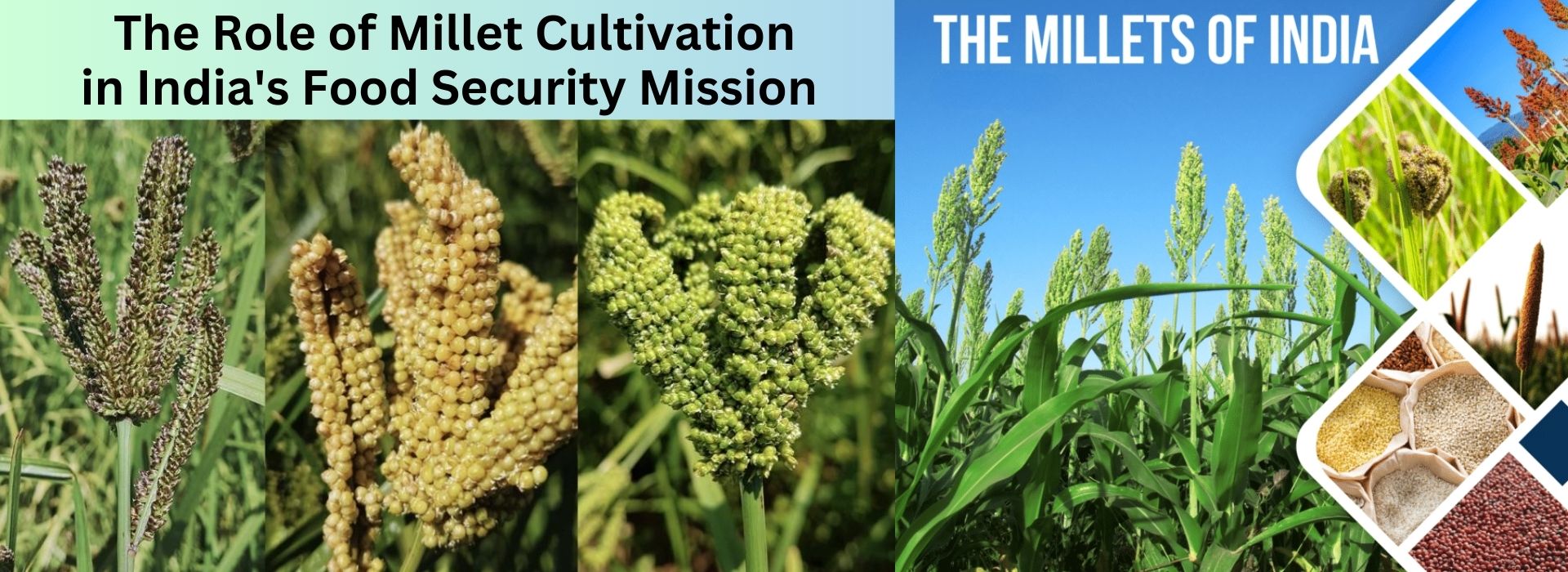The Role of Millet Cultivation in India's Food Security Mission
November 25, 2024The Role of Millet Cultivation in India's Food Security
Mission
Millets, often called "nutri-cereals," have been a
staple in India for centuries, known for their resilience, nutritional value,
and adaptability to diverse agro-climatic conditions. Recently, millets have
regained prominence due to their potential to address food security challenges
in a climate-vulnerable world. With the United Nations declaring 2023 as the
International Year of Millets, India's renewed focus on these crops highlights
their critical role in ensuring sustainable agriculture and nutrition security.
Why Millets Are Crucial for Food Security
- Climate
Resilience
Millets are drought-tolerant, require minimal water, and thrive in poor soils. This makes them ideal for cultivation in arid and semi-arid regions, which are vulnerable to climate change impacts like erratic rainfall and rising temperatures. - Nutritional
Superiority
Millets are rich in fiber, protein, iron, calcium, and other essential nutrients. They combat malnutrition and lifestyle diseases, such as diabetes and obesity, making them an excellent choice for a healthier population. - Economic
Empowerment of Farmers
Millets are low-input crops, reducing the cost of cultivation for small-scale and marginalized farmers. Additionally, promoting millets in global and domestic markets can enhance income opportunities. - Biodiversity
and Sustainability
Millets require fewer chemical fertilizers and pesticides, reducing the environmental footprint of farming. Their cultivation supports agro-biodiversity, which is critical for a resilient agricultural system.
India's Millet Revival Initiatives
- Policy
Support
- The
Indian government launched the National Food Security Mission (NFSM) to
increase millet production.
- Millets
were included in the Public Distribution System (PDS) to make them
accessible to low-income families.
- Millet
production is being incentivized under schemes like PM-Kisan and Kisan
Credit Card.
- Promotion
of Nutri-Cereals
- Campaigns
highlighting the health benefits of millets have gained momentum.
- The
"One District, One Product" initiative has encouraged
region-specific millet cultivation and marketing.
- Research
and Development
- Efforts
are underway to develop high-yield and climate-resilient millet
varieties.
- Improved
post-harvest technologies are enhancing the value chain for millet
products.
Challenges in Millet Cultivation
Despite their benefits, millets face several challenges:
- Market
Penetration:
Millets have yet to achieve the market presence of rice and wheat,
limiting their adoption.
- Consumer
Awareness:
Traditional consumption has declined due to changing dietary preferences.
- Policy
Gaps: While
supportive policies exist, implementation at the grassroots level needs
strengthening.
- Processing
Infrastructure:
Lack of adequate processing units affects millet product diversification.
Steps Forward
- Incentivize
Millet Cultivation: Provide better support prices, subsidies, and access to credit for
millet farmers.
- Promote
Awareness:
Educate consumers about the health and environmental benefits of millets.
- Enhance
Infrastructure:
Invest in processing and storage facilities to minimize post-harvest
losses.
- Leverage
Exports:
Position India as a global leader in millet production and export.
Conclusion
Millets are more than just a crop—they are a solution to some
of India's most pressing agricultural and nutritional challenges. By
integrating millets into mainstream agricultural policies and dietary habits,
India can not only safeguard its food security but also set an example of
sustainable farming practices globally.
Would you like to explore the economic impact or case studies
of millet success stories in India? Let me know!
At krishibazaar.in, you can find and buy various agricultural products. For agricultural guidance on selecting the most suitable products for your crops, please contact or WhatsApp at +917887880887






Guest reviews
No reviews found for this Blog